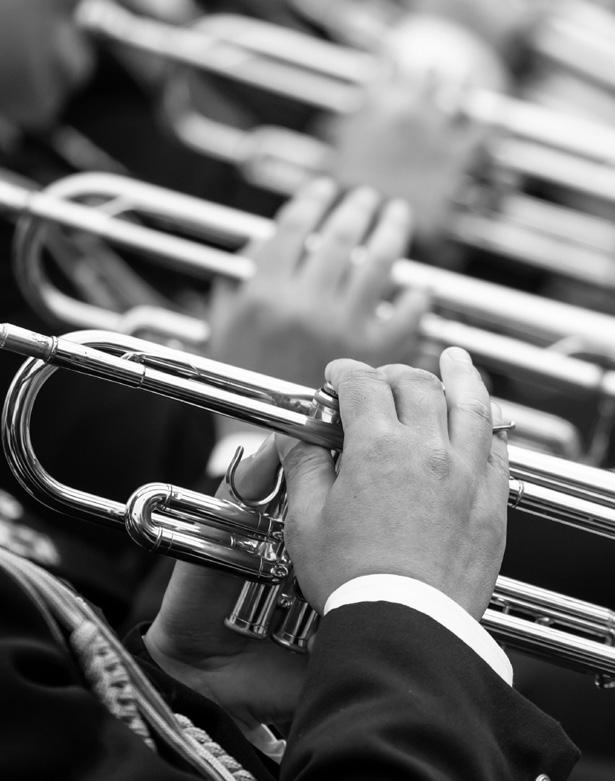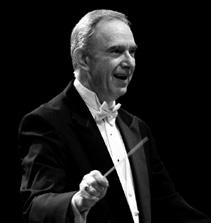
5 minute read
Rethinking The School Concert Presentation — Gary Barton
RETHINKING THE SCHOOL CONCERT PRESENTATION
BY GARY BARTON
“Some of my most miserable times as a high school band director were while helping corral middle school kids in the audience as they were waiting to play or had already finished playing.”
This statement didn’t originate with me, but I’ve lived this many times and I have few fond memories. The fact that there is a need to chaperone students in a gym or auditorium, in view of a large crowd that includes their parents, makes me wonder if maybe we could organize the event in a better way for the performers, the audience, and the music.
You have three concert bands in your middle school plus a large beginner band. Be proud! Those numbers are a picture of success and when people see that huge group of students all at once it’s impossible not to be a bit awestricken. Here’s a comparison: The lay public will assess a marching band on first sight based on the size. A big band must be a good band. They judge your middle school program the same way.
Now that we’re past the euphoria of having great numbers, what are some ways to showcase the students? It’s important to know that any scenario that will work in an auditorium will also work in a gymnasium or arena. If there are only two groups on the program, having a group play and then stay and listen to the other is good as long as the program will last an hour or less. Anything longer tests the attention span of the students who have already performed as well as that of small children in the audience. If either group needs thirty minutes or more, consider having the groups play on two different nights or have them play an hour apart, for example one group at seven o’clock and the other at eight o’clock. You can showcase a group better in its own time slot and you can play more music as well because you’re not trying to stay within a time limit. If two groups are sharing a concert in a gym, consider having both groups in a concert set-up on the gym floor and alternate selections between the two groups. The younger group plays the first piece followed by a piece by the advanced group, then the younger group again, continuing until the end with an exciting simple piece played together by both groups. The students and audience are engaged throughout the entire program and everyone plays on the finale.
A concert with three or four bands can become a chore. If you try to keep it within an hour, no group gets to play very long. If you require the first group to stay and hear the other performers, it can become grueling for everyone involved. Parents wonder why they have to stay an hour longer after their children have performed, while parents of students who perform last wonder why they had to arrive an hour or more before their children even play. When the concert is too long you’ll have an unhappy, but probably polite, audience that will dread the next event.
If you’re having three groups play on one evening, it’s possible to stagger the performances with each group getting its own time to play. I’ve often seen six-thirty as a starting time, but anything earlier tends to create problems for some working people; that extra thirty minutes makes a difference for many families. A six-thirty performance can be followed by a seven-fifteen or seven-thirty performance, followed by an eight o’clock or eight-fifteen performance. Remember that a middle school performance should
Gary Barton retired from the La Porte, Texas Independent School District after thirty-seven years of teaching in five states. He received the Bachelor of Music Education from the University of Louisiana-Monroe and the Master of Science in Education from Indiana University. A Past President of the Arkansas School Band and Orchestra Association and Past 2nd VicePresident of the National Band Association, he has written for numerous publications and has done clinics and presentations in sixteen states.
always happen within a half hour.
Another option for three or more bands is to simply use more than one evening. If there are three groups, the advanced group might possibly be able to play a longer program and an evening devoted to that group might be a healthy option. The other two groups can share an evening. For me, four groups dictates that we’ll use two evenings with one of the formats mentioned earlier. The pros: each group gets its own showcase and a concert doesn’t feel like a marathon to the audience. The cons: directors and families with multiple children may have to give up two evenings instead of one, and all students Rethinking the School Concert Presentation, Gary Barton cont.
won’t hear each other perform.
“Sure the kids need to hear each other, just not on every concert.” – Mike Fiske, Joliet Central High
School, Illinois, retired
Mike told me this and it struck me as brilliant because I have been told so many times, “We want the kids to hear each other and we want the parents to see the whole program.” Every program would be wise to plan a mass concert once a year that includes every performing group, possibly even the high school that the middle school feeds. A gym floor can hold all of the groups and they could even play in the alternating way mentioned earlier. A massed performance of all groups at the end creates a finale that the community will talk about for days. Keep each group at about ten minutes of music because you should still try to stay within that one hour of audience time.
A concert should be planned around what is best for the students instead of what is convenient. Every performance should leave the audience wanting more instead of feeling weary because of length. Rarely does anyone say, “I sure wish that concert had been longer!”











